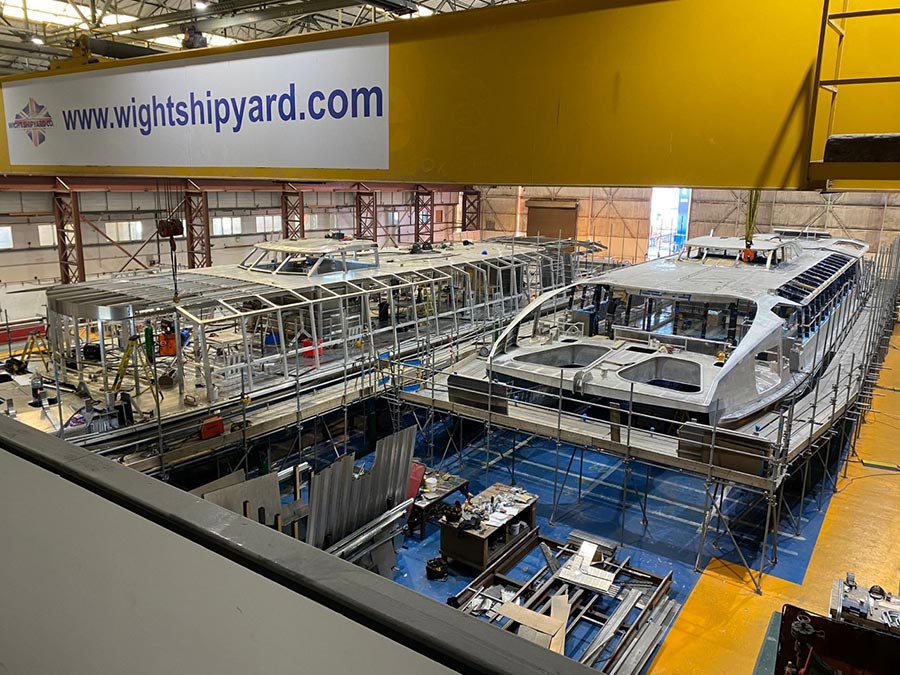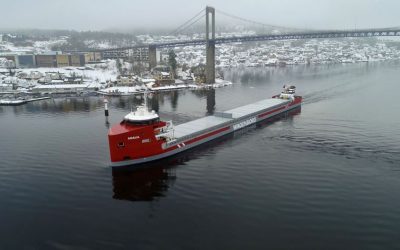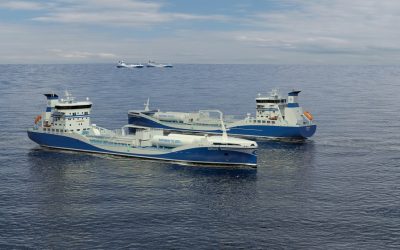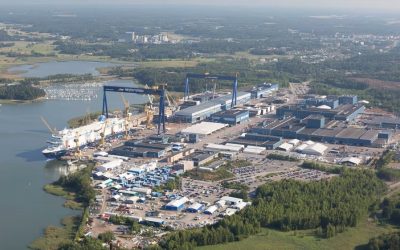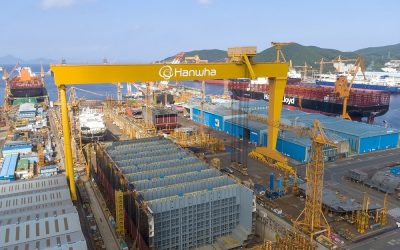Thames river cats prove a capital challenge for Wight Shipyard
Commissioned with building two Thames river cats for the Uber Boat by Thames Clippers service, Wight Shipyard Co. found that producing a low-emission solution was far from straightforward. Stevie Knight finds out about the challenges involved, and how the yard overcame them
You might believe from press reports that ferries are leapfrogging hybrid power and going straight to all-electric running – or even that low-emission versions are an easy win, supported by ready-to-install power solutions.
That’s just not the case, James Mozden, principal naval architect at Wight Shipyard Co. (WSC) tells Ship & Boat International. Implementing a low-emission solution can be complex, he explains – and moreover, despite the availability of all-in-one electric drive trains: “Off-the-shelf solutions won’t necessarily work where there are very specific demands on the route or vessel”.
Take the new Uber Boat by Thames Clippers. The ferry company serves 24 piers on a 25km stretch across London, from Putney in the west to Barking Riverside on the east side. There’s a 10-20 minute frequency between key London piers, and popularity is rising: estimates put passenger numbers at 4.9 million in 2022.
New boats are definitely needed. However, London has been waging a battle against emissions: in 2015, a study by King’s College London attributed over 9,000 excess deaths in the capital to air pollution in a single year – that is, before the low-emission zone was introduced for road vehicles. The resulting drop in emission-related deaths led to expanded regulation, and its success also implies these measures are a likely a precursor to what will happen on the river.
“Numerous challenges”
Consequently, WSC and naval architecture firm One2Three have been engaged in a five-year collaboration with the operator on its Hunt-class design. These 36m catamarans combine slender hulls with a shallow draught and low wave resistance to meet the challenges of limited depth and restricted bridge height – as well as keeping the wash down around London’s historic river architecture and other river users.
While the aim was for a green design with similar capacity to the previous vessels, there turned out to be “numerous challenges”, says Mozden. “Compared to standard diesel, all the available alternatives have a lower energy density, and storage of that energy is heavier and requires more space. Recharging also takes far longer, and you need to have charging points available.”
Further investigation showed a fully electric design “was just not feasible” – at least at this stage. It wasn’t down to any half-hearted foray into the subject: the ferry operator had previously studied the options for a zero-emission design but even recent developments weren’t enough to swing the result completely. As Mozden admits, a fully electric vessel “couldn’t meet the route schedule and berthing times as it only stops for a few minutes – you just can’t get enough into the batteries to support the duty cycle”. Further, he adds, there’s a requirement for “speeds of 20knots outside the emission control zone”.
Engine selection
As a result, a biofuel hybrid was settled on as the only realistic option – currently. But even that came with its own issues, as there’s a pretty hefty weight penalty on a hybrid drive train.
The new catamaran utilises IMO Tier III-compliant MAN D2682 engines in both hulls, scaled to propel the ferry up to 28knots: enough of a margin to deal with tidal flow and extra loads. Each engine is paired with a two-into-one reversing gearbox connected to the shafts of the Kongsberg S45 waterjets. These gearboxes are also fitted with a PTO/PTI from an electric motor: able to work in both directions, this can either drive the power train or feed the battery banks. It’s worth noting the speed doesn’t require enhancing with boost mode: “It’s simply not necessary here,” Mozden points out.
While scaling the engines was fairly simple, sizing the energy storage is notoriously tricky: the 475kWh Spear Li-ion energy storage – which works as a single unit, despite being divided between each hull for balance – should be capable of retaining an 80% charge after an eight-year lifespan, though the operator hopes to achieve more.
Although the batteries begin the morning fully charged courtesy of an overnight hook-up, the all-electric, 12knot transits through the ‘zero-zone’ stretch of the city would drain them significantly, undermining the all-important cycle life. To compensate, the batteries benefit from a regular top-up while the diesels are running.
However, to reduce NOx and SOx emissions on the longer legs of the route, the engines employ SCR scrubbers. Mozden adds: “To meet class requirements, we needed to install a water cooling system around the batteries, inverters and so on”.
Weight and wash
Altogether, this system came in at around 12.5tonnes – about 3.5 tonnes over a more standard powertrain. “It obviously adds quite a lump which needs to be reduced by making savings elsewhere,” Mozden explains. To mitigate, all areas within the vessel were assessed to see where the kilos could be trimmed. For example, the auxiliary gensets were removed, the fairly light hotel loads being routed to the battery instead.
The structure itself was also reviewed for weight-saving measures: even the welds were scrutinised. “As a rule of thumb, welding adds about 3% in mass,” says Mozden. Consequently, non-load bearing panels were riveted. “We also worked with suppliers to assess all components on a weight basis as well as functionality,” he adds. It all counts when you’re watching the scales.
However, there was still a significant impact on displacement and therefore wash – minimising this is a key demand for operating on the Thames. The solution had to be a revision of the 36m hull, but Mozden underlines there was a limit to how much could be altered – and the outline of the previous Uber Boat vessels needed to be retained as far as possible.
“Too much change and the dissimilarities with the other vessels get too great, which means you are facing issues with the docking requirements, the piers, bow lines and so on,” Mozden says. As with the earlier ferries, the new vessel requires a low wheelhouse to pass under the bridges at the western end of the Thames, constraining the design vertically. Wash and navigation concerns meant retaining the slim 8.3m beam; the draught had to remain at 1.1m; and, to top it all, Mozden points out: “Everything has to be the same place as in the other vessels or the skippers can’t work across the fleet”.
So, it was decided to lengthen the vessel by an extra 2m, taking it up to 38.33m. This increased buoyancy and space for the hybrid kit. Mozden adds that the revision doesn’t seriously impact turning or handling, as “twin waterjets make the vessel very manoeuvrable”.
The rules also have an impact. Mozden underlines that working with both the latest equipment and the latest regulations isn’t easy, especially as alternatives to diesel bear additional risk burdens. He elaborates: “For example, Li-ion batteries require their own approach to fire suppression, so we had to work with class to develop a suitable system – all while not exceeding the weight budget.” Additionally, obtaining clarity on how to interpret both class and MCA regs for relatively new technology “is an issue that can lead to interesting challenges in its own right”, he says.
Procurement and integration were not straightforward either. “It isn’t just batteries you have to add; it’s also new controls,” says Mozden. That in turn meant dealing with new and unfamiliar supply chains, who weren’t necessarily familiar with each other. “We often ended up by joining the dots between the different providers,” he says.
Fuel alternatives
Interestingly, the two new Uber vessels may not live out their lives as biofuel hybrids. “Given the speed at which emission regulation is moving at the moment, a future-proof vessel is critical,” says Mozden. “Our idea is to do the best we can at the time, with the view that it can be improved in the future with new technology able to increase these vessels’ energy density, range and performance.”
In fact, the teams are looking across a range of alternatives: for example, dual-fuel diesel and hydrogen or methanol combustion. It may be that future developments allow for increased power storage until the vessel is fully electric, while hydrogen fuel cells or other kinds of power could play a supporting role – or possibly take over entirely. It partly depends on availability of supply, as well as shoreside infrastructure for charging/refuelling.
As of late November 2022, the first of the initial WSC builds was entering mechanical and interior fit-out, while structural work was just starting on the second. Both will enter into service later this year.
In conclusion, Mozden concedes that the project has been an interesting learning curve:
“It’s been more complex than we initially anticipated…development was much more focused on how the boat is actually used, not just ‘what she can do at top speed’, which is the usual request. That meant digging a lot deeper into how the vessel is actually used and finding out what ‘performance’ really means for the owner.”
